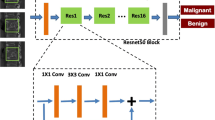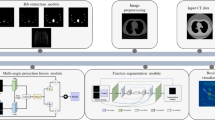Abstract
Spine fractures represent a critical health concern with far-reaching implications for patient care and clinical decision-making. Accurate segmentation of spine fractures from medical images is a crucial task due to its location, shape, type, and severity. Addressing these challenges often requires the use of advanced machine learning and deep learning techniques. In this research, a novel multi-scale feature fusion deep learning model is proposed for the automated spine fracture segmentation using Computed Tomography (CT) to these challenges. The proposed model consists of six modules; Feature Fusion Module (FFM), Squeeze and Excitation (SEM), Atrous Spatial Pyramid Pooling (ASPP), Residual Convolution Block Attention Module (RCBAM), Residual Border Refinement Attention Block (RBRAB), and Local Position Residual Attention Block (LPRAB). These modules are used to apply multi-scale feature fusion, spatial feature extraction, channel-wise feature improvement, segmentation border results border refinement, and positional focus on the region of interest. After that, a decoder network is used to predict the fractured spine. The experimental results show that the proposed approach achieves better accuracy results in solving the above challenges and also performs well compared to the existing segmentation methods.













Similar content being viewed by others
References
Glessgen, C.G., Cyriac, J., Yang, S., Manneck, S., Wichtmann, H.M., Wasserthal, J., Kovacs, B.K., Harder, D.: Segment and slice: A two-step deep learning pipeline for opportunistic vertebral fracture detection in computed tomography. In: medRxiv (2022). https://api.semanticscholar.org/CorpusID:254066460
Healthline: Spine. https://www.healthline.com/human-body-maps/sternum (2023)
Park, T., Yoon, M.A., Cho, Y.C., Ham, S.J., Ko, Y., Kim, S., Jeong, H., Lee, J.: Automated segmentation of the fractured vertebrae on ct and its applicability in a radiomics model to predict fracture malignancy. Scientific Reports 12 (2022)
Zhang, Q., Du, Y., Wei, Z., Liu, H., Yang, X., Zhao, D.: Spine medical image segmentation based on deep learning. Journal of Healthcare Engineering 2021 (2021)
Kim, K.C., Cho, H.C., Jang, T.J., Choi, J.M., Seo, J.K.: Automatic detection and segmentation of lumbar vertebrae from x-ray images for compression fracture evaluation. Computer Methods and Programs in Biomedicine 200, 105833 (2021) https://doi.org/10.1016/j.cmpb.2020.105833
Golla, A.-K., Lorenz, C., Buerger, C., Lossau, T., Klinder, T., Mutze, S., Arndt, H., Spohn, F., Mittmann, M., Goelz, L.: Cervical spine fracture detection in computed tomography using convolutional neural networks. Physics in Medicine & Biology 68(11), 115010 (2023) https://doi.org/10.1088/1361-6560/acd48b
Chan, Y.-K., Lin, C.-S., Lin, H.-J., Yip, K.-T.: Segmentation of spinal mri images and new compression fracture detection. Software Engineering, Artificial Intelligence, Networking and Parallel/Distributed Computing (2022)
Benzakour, A., Altsitzioglou, P., Lemée, J.-M., Ahmad, A.A., Mavrogenis, A.F., Benzakour, T.: Artificial intelligence in spine surgery. International Orthopaedics 47, 457–465 (2022)
Small, J.E., Osler, P.M., Paul, A., Kunst, M.M.: Ct cervical spine fracture detection using a convolutional neural network. American Journal of Neuroradiology 42, 1341–1347 (2021)
Sunder, A., Chhabra, H.S., Aryal, A.: Geriatric spine fractures - demography, changing trends, challenges and special considerations: A narrative review. Journal of clinical orthopaedics and trauma 43, 102190 (2023)
Chen, X., Zhang, R., Yan, P.: Feature fusion encoder decoder network for automatic liver lesion segmentation. 2019 IEEE 16th International Symposium on Biomedical Imaging (ISBI 2019), 430–433 (2019)
Wu, H., Zhang, J., Huang, K.: Sparsemask: Differentiable connectivity learning for dense image prediction. 2019 IEEE/CVF International Conference on Computer Vision (ICCV), 6767–6776 (2019)
Zhang, Z., Zhang, X., Peng, C., Cheng, D., Sun, J.: Exfuse: Enhancing feature fusion for semantic segmentation. In: European Conference on Computer Vision (2018). https://api.semanticscholar.org/CorpusID:262349636
Hu, J., Shen, L., Albanie, S., Sun, G., Wu, E.: Squeeze-and-excitation networks. 2018 IEEE/CVF Conference on Computer Vision and Pattern Recognition, 7132–7141 (2017)
Chen, L.-C., Papandreou, G., Kokkinos, I., Murphy, K.P., Yuille, A.L.: Deeplab: Semantic image segmentation with deep convolutional nets, atrous convolution, and fully connected crfs. IEEE Transactions on Pattern Analysis and Machine Intelligence 40, 834–848 (2016)
Bock, S., Weiß, M.G.: A proof of local convergence for the adam optimizer. 2019 International Joint Conference on Neural Networks (IJCNN), 1–8 (2019)
Ronneberger, O., Fischer, P., Brox, T.: U-net: Convolutional networks for biomedical image segmentation. ArXiv abs/1505.04597 (2015)
Zhou, Z., Siddiquee, M.M.R., Tajbakhsh, N., Liang, J.: Unet++: A nested u-net architecture for medical image segmentation. Deep Learning in Medical Image Analysis and Multimodal Learning for Clinical Decision Support : 4th International Workshop, DLMIA 2018, and 8th International Workshop, ML-CDS 2018, held in conjunction with MICCAI 2018, Granada, Spain, S... 11045, 3–11 (2018)
Badrinarayanan, V., Kendall, A., Cipolla, R.: Segnet: A deep convolutional encoder-decoder architecture for image segmentation. IEEE Transactions on Pattern Analysis and Machine Intelligence 39, 2481–2495 (2015)
Shelhamer, E., Long, J., Darrell, T.: Fully convolutional networks for semantic segmentation. 2015 IEEE Conference on Computer Vision and Pattern Recognition (CVPR), 3431–3440 (2014)
Han, Z., Wei, B., Mercado, A., Leung, S., Li, S.: Spine-gan: Semantic segmentation of multiple spinal structures. Medical Image Analysis 50, 23–35 (2018)
Chen, L.-C., Zhu, Y., Papandreou, G., Schroff, F., Adam, H.: Encoder-decoder with atrous separable convolution for semantic image segmentation. In: European Conference on Computer Vision (2018). https://api.semanticscholar.org/CorpusID:3638670
Author information
Authors and Affiliations
Contributions
Muhammad Usman Saeed and Wang Bin conceptualized the study, with contributions from Jinfang Sheng. Methodology, formal analysis, data curation, and writing original draft were prepared by Muhammad Usman Saeed. Methodology development, validation, supervision, and review original draft was done by Wang Bin. Muhammad Usman Saeed and Wang Bin validated the methodology. Formal analysis, investigation efforts, data curation, and supervision were conducted by Jinfang Sheng. Data curation, validation, and formal analysis were conducted by Hussain Mobarak Albarakati.
Corresponding author
Ethics declarations
Ethical Approval
Not applicable
Informed Consent
Not applicable
Consent for Publication
Not applicable
Competing Interest
The authors declare no competing interests.
Additional information
Publisher's Note
Springer Nature remains neutral with regard to jurisdictional claims in published maps and institutional affiliations.
Rights and permissions
Springer Nature or its licensor (e.g. a society or other partner) holds exclusive rights to this article under a publishing agreement with the author(s) or other rightsholder(s); author self-archiving of the accepted manuscript version of this article is solely governed by the terms of such publishing agreement and applicable law.
About this article
Cite this article
Saeed, M.U., Bin, W., Sheng, J. et al. An Automated Multi-scale Feature Fusion Network for Spine Fracture Segmentation Using Computed Tomography Images. J Digit Imaging. Inform. med. (2024). https://doi.org/10.1007/s10278-024-01091-0
Received:
Revised:
Accepted:
Published:
DOI: https://doi.org/10.1007/s10278-024-01091-0




